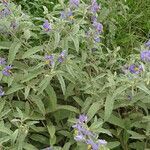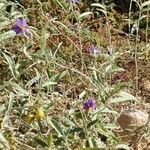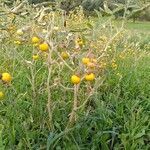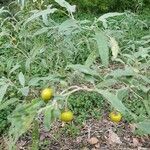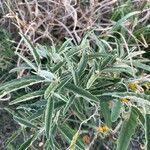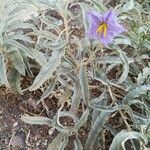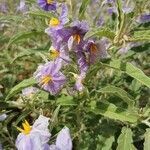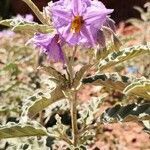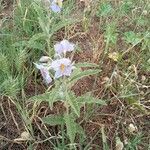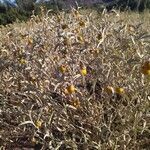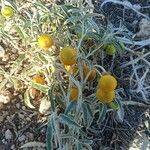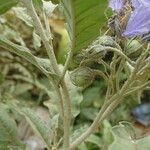Annual, herbaceous shrublet; roots perennial, deep, spreading; vegetative parts, calyx and corolla with silvery-white, dense pubescence outside. Prickles few to many, straight, up to 5 mm long. Leaves linear to sublanceolate, plicate, glaucous-green, stellate-pubescent above; petioles up to 25 mm long. Inflorescence with peduncles short, woolly; pedicels up to 40 mm long. Calyx 10 mm long, 5-ribbed, deeply lobed, long-acuminate, enlarged in fruit. Corolla up to 15 x 30 mm, white, mauve, blue inside. Flowering time Oct.-Mar. Fruit globose, ± 12 mm in diam., smooth, shiny, green with white patches to ± yellow. Seeds many, lenticular, 3 mm in diam., ± smooth, green-brown.
A herb. It keeps growing from year to year. It is covered with a greyish white down. The stems can be 1 m high. They may have a few slender prickles. The leaves are oblong or sword shaped. They are 5-10 cm long. The edges are wavy. The whitish down is thicker under the leaf. The flowers are large and violet or blue. They are 2 cm across. The flowers have 5 petal like lobes that are joined at the tip of each lobe. The first flowers are at the ends then later flowers in the axils of leaves. The stamens are yellow. The fruit are like small tomatoes. They are 1 cm across.
Dwarf shrub or shrub, up to 0.6 m high. Spines straight, many, reddish, also so on petiole and midrib of leaf. Leaves petiolate; blade ovate to narrowly ovate, apex acute, base ± truncate, margins entire to slightly wavy, upper surface green, lower whitish or silvery stellate-pubescent. Flowers: in corymbose cymes towards tips of branches, peduncles shortly, densely pubescent; corolla > 15 mm in diameter, mauve; Oct.-Mar. Fruit a yellow berry, 12 mm in diameter.
Poisonous shrublet, with deep, spreading rootstock and annual stems, up to 0.6 m tall, bearing dense, silvery-green, stellate hairs, and often with straight, slender, reddish prickles, up to 5 mm long. Leaves petiolate, linear to lanceolate, up to 110 mm long, folded upwards, margins wavy. Flowers in terminal racemes, up to 20 mm long, white, mauve or blue. Berries mottled green, turning yellow, shiny, 12 mm diam.
Coarse, branching, rhizomatous perennial to 1 m, spineless or sparsely spiny, silvery-canescent with stellate hairs throughout; lvs linear to oblong or lance-oblong, 5–15 cm, a sixth to a third as wide, entire or merely sinuate; fls violet, 2 cm wide; 2n=24, 72. Dry soil; Mo. and Kans. to Tex. and Ariz., and occasionally adventive eastward.
Small spiny shrub, up to 0.6 m high. Spines straight. Leaves entire to sinuate, stellate-pubescent. Flowers in corymbose cymes towards apices of branches. Corolla up to 30 mm in diameter. Fruits yellowish. Flowers mauve.
